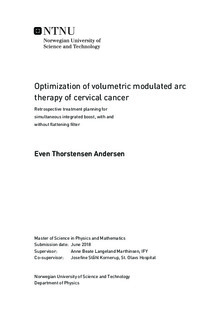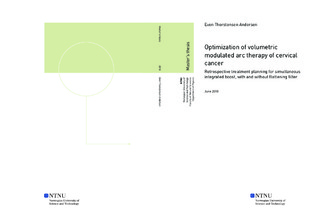| dc.description.abstract | The traditional treatment of cervical cancer is external beam radiotherapy (EBRT) combined with brachytherapy (BT) and concomitant chemotherapy. BT is used to boost the primary tumor in the pelvic area towards the end of the EBRT. In patients where the cancer has metastasized to nearby lymph nodes, external radiation boost is given to the affected lymph nodes. Traditionally this lymph node boost has been given sequentially, that is, after the EBRT of the primary pelvic target. Modern treatment techniques as intensity modulated radiotherapy (IMRT) and volumetric modulated arc therapy (VMAT) have made it easier to deliver the boost at the same time as the EBRT of the pelvic target. This is called simultaneous integrated boost (SIB). VMAT treatment with SIB is now a common practice for EBRT of cervical cancer patients with regional affected lymph nodes.
The most commonly used modality for EBRT is photon radiation (6MV), which is generated in a linear accelerator (linac) where several mechanical elements are used to generate and shape the photon beam properly. One of these is the flattening filter, which is used to flatten the fluence profile of the beam. This filter may also be removed, which will preserve the cone shaped profile of the photon beam in a so-called flattening filter-free (FFF) beam. EBRT with FFF beams is given with higher dose rate (and possibly reduced treatment time) than beams with flattening filter, and can be used for treatment of several cancer types.
\\\\
In this master project 15 patients were included, which had previously received radiotherapy for cervical cancer at St. Olavs Hospital, with EBRT, BT and sequential EBRT boosting of metastatic lymph nodes. In this study, both standard 6MV VMAT and FFF VMAT treatment plans including SIB were made retrospectively for all patients. The standard 6MV plans and the FFF plans were evaluated and compared in terms of whether or not they could fulfill defined dose constraints, in addition to comparison of the homogeneity and conformity of the plans. All plans were further delivered to a quality assurance (QA) phantom, to assess how well these plans could be delivered by a clinical linac. Several parameters were extracted from the QA measurements, and the 6MV and FFF plans were further compared with respect to these. The aim was to examine whether or not FFF plans could be delivered with the same accuracy from a linac, as the corresponding 6MV plans.
Both standard 6MV and FFF treatment plans were satisfactory with respect to dose coverage of target volumes, and they were about equal in sparing of nearby organs at risk. However, data from the QA measurements showed that the 6MV plans were more accurately delivered to the QA phantom, compared to the corresponding FFF treatment plans. Therefore, for the complex and inhomogeneous volumes to be irradiated in patients with cervical cancer with lymph node metastases, the standard 6MV VMAT SIB plans are preferred to FFF plans. | |

